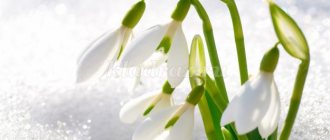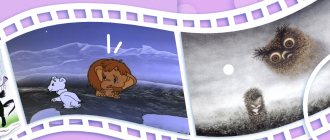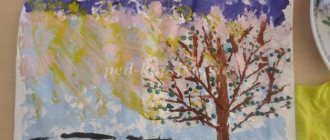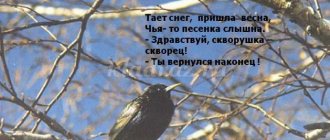Summary of an educational lesson in the preparatory group on the topic: “Spring is coming to us...”
Educational lesson on the topic: “Spring is coming to us...”.
Preparatory group. Program content: - to evoke in children a feeling of admiring admiration for the beauty of their native nature, a desire to express their impressions in words, in a verbal description, select epithets, comparisons for a given word, exercise in the formation of different forms of verbs and the comparative degree of adjectives.
Show the awakening of nature and teach children to observe the signs of spring throughout its entire length, determine the sequence of events in nature and their connections. To develop the ability to perceive the mood reflected by the artist in the landscape and convey it in his statements. Expand children's ideas about early spring. Strengthen the ability to distinguish and name wintering and migratory birds. Develop memory, attention, logical thinking and imagination. To cultivate a love for nature, the ability to feel its beauty, love for one’s native land. Course of the lesson
Organizational moment We are all friendly guys, We are preschool children. We don’t offend anyone, we know how to care. We will not leave anyone in trouble, we will not take away, but we will ask. Let everyone be well, May it be joyful and light. Educator: Guys, if you solve these examples correctly, then you will find out what we will talk about in class. Children fill in the letters and read the word.
Educator: Well done, guys! How do you understand the expression: “Spring is coming!” Children: 1. From mid-March, from the first thawed patches, you can notice the appearance of spring. There is still snow, nothing has changed, but everything in nature is still changing. There are bare trees on the street. It may snow, it may drip from the roofs, the days may be gloomy. 2. If the sun appears, it shines so brightly that sometimes it just hurts the eye. The air is clear, clean, slightly frosty. The sky is bright blue. Educator: The sun has come to us, but there are few rays. Why? (We listen to the children's answers.) I think if you guys tell us more signs of spring, the sun will have more rays. Children: 3. Conversation on the topic. - Guys, what day is it today, day of the week, month? What time of year? —Are you waiting for spring? So she came. In winter, all nature slept, bound by snow and ice. In spring everything around comes to life. - Let's tell her: “Hello, Spring!” What months did Spring bring with it? — What are the spring months in order? — What are the first signs of the coming spring? Expected answers from the children: - The sun began to warm up during the day. — It has become warmer, the days have become longer. — The snow darkened and began to melt. — The first thawed patches have appeared. — You can hear the ringing chirping of sparrows, they rejoice at the coming of spring. - We ran, the streams began to ring. — Migratory birds are returning. We are also all dressed warmly - In sweatshirts, in cotton pants... And yet the signs of spring are already visible in everything, in everything. — What signs of early spring do you know? Expected answers from children: - Rook on the mountain - spring is in the yard. - In March, even a chicken will drink from a puddle. - Spring and autumn - there are eight weather conditions per day. - Why do they say: “Spring and autumn - there are eight weather conditions per day.” Game “Say with the word “spring”. I say the word “weather”, and you answer me “spring weather”, etc.
(throw the ball to the child and say the word). Words: day, rain, mood, thunderstorm, sun, months, forest, grass, sky, flowers, freckles. Physical exercise.
The sun began to warm up, The droplets began to knock, A drop once, a drop two, The drops were slow at first, And then the streams ran faster, faster, Try to catch them!
A game of attention. I'm called months.
If the month is summer, then you wave your hands in your face (it’s hot). If it’s autumn, then you squat (collect potatoes). If it’s winter, then we dance and spin like snowflakes. If it’s spring, then we raise our hands up and stretch, grow. March, June, September, May, February, April, July, December, March, August, January, March, October. - Do you know how many months spring will last? And now “Say a word.” Winter has passed and everyone is happy. Spring is hurrying, And the month... (March!) Behind it another knocks on the door, And it's called... (April!) And remember the third month, What is it called? ... (May!) The teacher invites the children to listen to birdsong (audio recording). - Children, who brings spring on his wings? (Birds) - What are these birds called? (Migratory) - Why are they called migratory? —What do you call birds that don’t fly away? (Wintering) Physical exercise.
Outdoor game “Wintering and migrating”. - Let's relax and play. If I name a migratory bird, “fly” and “flapping your wings.” If I name wintering birds, squat down and clap your hands. Rook, crossbill, bullfinch, starling, swallow, titmouse, sparrow, lark, crane. - Well done, you know birds well. Sit on the chairs. Educator: The sun laughs tenderly. It shines brighter, hotter, and a talkative stream flows loudly from the hillock. — Noisy streams began to flow into holes and dens. Who did they wake up? (answers) – showing pictures (bear, hedgehog, badger)! What else wakes up in the spring? Plants. — What early flowering plants do you know? (showing early flowering plants on the slide) -Coltsfoot (a tincture is prepared from the leaves to treat colds) -Blooms from under the snow The earliest to greet spring (snowdrop) are blue and white -What was the name of the heroine of N. Nosov’s work about Dunno who prepared medicine and treated her friends? (Lungwort) medicinal lungwort (changes color four times: pink - red - purple - blue. Visited by bees and bumblebees) - May lily of the valley (the flowers are used to make perfume) - Oak anemone. What word is hidden in the title? (The flowers are white. Flowering coincides with the period of winds. Poisonous. Dangerous for livestock) All early flowering plants have either a thickened rhizome or a bulb underground. Nutrients have been deposited in them since autumn. Due to these reserves and heat, these plants bloom first, rush to pollinate and form seeds before the general flowering. Plant protection. — Very often in early spring you can see people selling early flowering plants (snowdrops) or returning from the forest with bouquets of flowers that are on the verge of extinction. I picked a flower in the meadow while running, I picked it, but I can’t explain why. It stood in the glass for a day and withered. How long would it have stood in the meadow? — What can you and I do to preserve plants? (in the forest, move along paths, because the death of herbaceous plants has a detrimental effect on the condition of the entire forest; make bouquets from flowers that a person has grown in his own garden; do not collect birch sap) Well done! — Now let’s play the game “Choose the correct answer.” 1. After what time of year does spring come? Summer. Winter. Autumn. 2. What do people call spring? Day of the year. Morning of the year. Night of the year. 3. Who cries only in spring? Children. Icicles. Adults. 4. What happens to the ice on the river in spring? Ice jump. Ice run. Ice drift. 5. Which birds arrive first in spring? Swallows. Nightingales. Rooks. 6.What appears in the fields when the snow melts? Thawed patches. Zatalinki. Obtalinki. Work based on the painting by I. Levitan “Spring. Big water." The teacher shows the children the painting “Spring. Big water." Many years ago, a wonderful artist I. Levitan lived in our country. He painted pictures in which he depicted his native nature: slender birch trees, rivers, the sky. The paintings of I. Levitan are loved and known not only here, but also in other countries. Today we will look at his painting “Spring. Big water."
Questions: 1. What do you think the artist wanted to tell us about spring? 2. What does the artist find interesting and beautiful? 3. Why did Levitan name his painting “Spring. Big water? Work on cards “Cross out what doesn’t belong to spring”
We recommend watching:
GCD summary for the senior group on the topic: “Expedition to the taiga” Scenario of an educational trip-acquaintance “Electricity and electrical appliances” for kindergarten GCD summary for cognitive development in the senior group of kindergarten on the topic: Winter GCD summary for children of the middle group “Geometric Kaleidoscope”
Similar articles:
Summary of GCD in the senior group on the topic “Young Experimenters”
Conversation on the topic “Rain” in the senior group
Conversation on the topic “Pond” for children of the preparatory group
Conversation about the forest in kindergarten in the senior group
About wheat for older children
Summary of a lesson in a preparatory group using ICT on the topic: Spring
Lesson in the preparatory group “We are the messengers of young spring!”
Author: Kovalchuk Valentina Nikolaevna. Educator. Kindergarten No. 90. city of Tyumen. Description: This development may be of interest to kindergarten teachers and primary school teachers. It was interesting to select the video materials myself. Goal: Development of cognitive interest in native nature and art. “To take care of the Earth, nature, you need to love it, in order to love it, you need to know it, having learned it, it’s impossible not to love it...” A.N. Sladkov Objectives: Expand and systematize knowledge about migratory birds.
Expand preschoolers’ understanding of changes in nature in spring. Cultivate a respectful attitude towards nature. Learn to see the beauty of spring nature. Continue to teach to notice the beauty of spring nature in music, painting, and poetry. Progress of the lesson
Educator: Spring is coming, and with the appearance of the first thawed patches, migratory birds from warm countries return home.
Which birds return first? Using presentation slides:
1. Child: I look like a crow, But my beak is whiter. I walk behind the tractor in search of worms. The crow nervously “caws”, and I say “krra” in a respectable manner. The crow is lonely, and I have a Family. (Rook)
Educator: With the appearance of the first spring thawed patches, rooks arrive. Wandering along the melted roads, a rook rummages through horse manure, selecting oat seeds. In thawed areas he looks for seeds of last year's grasses. When plowing begins, he walks behind the tractor, looking for earthworms, beetles and larvae. The rook's beak became white from constant picking in the ground. Rooks settle in colonies. Rookeries can have up to 300 nests. Educator: Let's listen to the voices of the rooks. 2. Child: I arrive with the drifting ice, they call it Icebreaker. I run lightly and quickly, shaking my tail. And I sing the melodic song “Tsivit, ciss, siss.” (Wagtail)
Educator: In central Russia, the white wagtail arrives at the end of March, the very beginning of April. The wagtail can be seen on trees and on the roofs of houses. At first, as a rule, they are located near the river, they can even fly from one floating ice floe to another. Later they migrate to parks and squares. It feeds mainly on insects, less often on berries and seeds. Educator: Let's listen to the voice of the wagtail. 3. Child: The snow hasn’t melted yet, we’re already arriving. We soar easily over rivers and lakes. Silver and white rocking on the waves. We happily eat fish and insects. (Link-headed gull, or river gull, or common gull)
Educator: The black-headed gull, or the common gull, or the common monkey, arrives very early. in early April, when all the snow has not melted, and by the end of April nests with clutches are already found. A seagull has flown in - spring has come to the lake. Its wingspan is about a meter, its head in spring and summer is dark brown, its back and wings are light gray, its beak and legs are dark red, a wide white stripe in the upper front part of the wing and a narrow black stripe in the back of the wing. Educator: Let's listen to the voices of the seagulls. 4. Child : With a small flock, built in a row, I arrive from the south in early spring. I’ll flap my blunt, wide wings at a special angle, And I can handle flips, pitching, and “corkscrews” easily in the air. (Pepwing, or Pigalitsa)
Educator: The first lapwings arrive very early at the end of March - the first half of April. Chibis is well known not only to rural residents, but also to many city dwellers. Having noticed a person, the lapwing greets him with a questioning cry “pi-i-vit, pi-i-vit”, similar to the words “whose-you, whose-you”. In the spring, the lapwing screams “kyby-kuuyb, kybyy-kuuyb.” The lapwing feeds mainly on beetles and their larvae. At the end of April, fresh clutches of eggs appear. Educator: Let's listen to the singing of the lapwing. 5. Child: There is a hole on the ice. I will find greenery there. The head is large, the tail is short, and the beak is large and flat. (Mallard, or mallard duck)
Educator: In early April, when the reservoirs are still covered with ice, mallards stay in the ice holes. They feed on overwintered green plants. At the end of April, eggs appear in the nests. The drake wears its mating plumage all winter and spring, until the summer molt begins. It feeds on plant foods (duckweed, hornwort, etc.), as well as small aquatic animals (fish, invertebrates, insects, frogs). Educator: Let's listen to the voice of the mallard.
Outdoor game “Migration of birds”
Description of the game: Children - birds stand scattered on one side of the room. At the teacher’s signal, “The birds are flying out,” the children fly with their arms raised to the sides. At the signal “Storm,” the birds crouch down, covering their heads with their hands, hiding from the storm. When the teacher says that “The storm has stopped,” the bird children continue on their way. (You can choose music for “flight” and “storm”). 6. Child: You see him at the porch - That means spring has come. Like a real artist, he will repeat any sounds or songs of birds. (Starling)
Educator: Starlings usually return in late March - early April. Starling is a mockingbird. Its songs consist of its own long soft "squeaking" sounds, songs borrowed from other birds, animal calls and other sounds. Starlings use their long beaks to select various worms, larvae, and pupae from the ground. In winter, the tips of the feathers wear away, causing numerous white and cream specks to appear. After the spring molt, the plumage of starlings again becomes monotonous brown. Educator: Let's listen to the starling singing. 7. Child: I am a resident of meadows and fields. You won't find me in the forest. I am a famous singer - I sing high above the ground. (Lark)
Educator: Skylarks - males arrive first to occupy the first thawed patches, where they gather in groups and bask in the sun. Later, the females arrive and begin to look for the most convenient place for nesting. The male is engaged in guarding and singing. A young male can sing 8 hours a day. Skylarks in early spring eat the germinating seeds of various grasses and cereal plants. Later, the diet is replenished with various insects. Favorable weather allows the skylark to hatch two chicks. Child: Poem by V. Zhukovsky “Lark”. In the sun the dark forest glowed, in the valley thin steam whitens, and a clear lark sang an early song in the azure. He sings loudly from above, sparkling in the sun: Young spring has come to us, I sing here the coming of spring. Educator: Let's listen to the lark singing. Educator: Early spring inspires artists to paint spring landscapes. On them: the awakening of nature from winter sleep, the air is transparent, the crystal-white March snow melting under the rays of the bright sun, the trees cast their long blue shadows on it. Artists describe spring with colors, and composers with sounds. Now we will look at the beautiful spring March landscapes of Russian artists, and enjoy the music of P.I. Tchaikovsky. Child: Apollo Maykov The field is rippling with flowers... Waves of light are pouring in the sky... Spring larks are singing, Blue abysses are full. Listening to music and viewing slides:
“The Lark's Song.” March. From the series “Seasons”
.
Lesson summary
Educator: Which birds are the first to arrive from warm regions? What kind of music did we listen to? Child: Mikhail Dudin Take care of the earth.
Take care of the lark in the blue zenith, the butterfly on the leaves of the dodder, the sun's glare on the paths. On the stones there is a playing crab, Over the desert the shadow of the baobab tree, A hawk soaring over the field, A clear moon over the river calm, A swallow flickering in the life. Take care of the earth! Take care! Presentation on the topic: We are the messengers of young spring!
We recommend watching:
Summary of a lesson in a preparatory group on a spring theme with the use of ICT “Walk around the world” Summary of a lesson on the topic: Spring for children of a preparatory group for school Summary of GCD on drawing with elements of experimentation in the preparatory group of a kindergarten Subgroup lesson on sound automation R in the preparatory group
Similar articles:
Summary of a lesson in the preparatory group on the topic: Spring
Reading competition in the spring in kindergarten. Senior – preparatory group
Scenario of the spring game program for children of the senior group in kindergarten
Spring holiday “The Arrival of Birds” in kindergarten. Senior – preparatory group
Spring fair in kindergarten. Scenario. Senior – preparatory group



